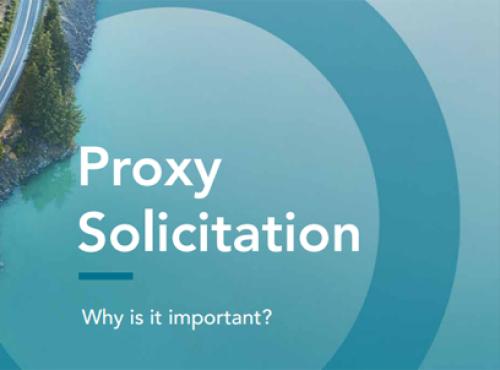A report from IR Magazine’s Investor Perception Seminar in Toronto and the West Coast Think Tank in Palo Alto
IR Magazine’s events in Toronto and Palo Alto explored several issues from different perspectives that can be summed up as the challenges faced by IROs shaping their companies in changing – sometimes uncertain – times.
Former UK prime minister Harold Macmillan once proclaimed that events could blow the best-laid plans off course; in Toronto, those events were summarized as Donald Trump’s election victory and the US economy.
Much discussion was given over to the US economy, which the consensus outlook suggests is now in good shape: the nation is close to full employment, with good GDP growth, inflation below 2 percent and profits up, all contributing to an environment in which business investment could be revised upward. ‘What I took away were the strong underlying drivers for the US market and economy,’ said one IRO.
Both events also tackled the issue of board-investor interaction, with the view that many more board interactions are now taking place, requiring greater proactivity from IROs toward the board and senior management. It was noted that it is often down to how much reach into the boardroom the IRO has. As one major corporate IRO said, this is fundamentally important and strikes at the heart of being an effective IR professional: ‘You are never going to convince [the board] if you only meet it once a year. You have to build that credibility via the IRO role and with your internal management team before you have that credibility with the board.
‘As a senior IRO you are serving the management team but also the board, on behalf of investors. If you have no interaction with it you are clearly not being as effective as you could be.’
The meetings dilemma
To meet with investors or not to meet with investors? That is the IR question that needs to be put to the board. At both think tanks, board interaction was seen as vitally important, and it was noted that it had recently become more common. For some, this was a deliberate policy, with many IROs saying they had put in place a board policy to have greater interaction with investors.
Not everyone agreed, however, prompting the question: how much time do investors have to do this? And will they know how to do this to the benefit of all parties? In response, one IRO said: ‘We offer meetings and some of our biggest investors didn’t feel it was something they wanted to do. It may have been the topic, but we were offering them the chance to meet one of our senior board directors and I am slightly surprised they didn’t take it up.’
This, the IRO explained, has wider ramifications for board-investor meetings: ‘You end up doing meetings less relevant to the overall weight of the register and then you ask yourself whether that’s a good use of the board’s time.’
Another IRO asked an equally valid question: ‘What does that interaction look like? And how do you manage it?’ A third leading corporate IRO said there were no simple answers. ‘I don’t think anyone has the magic answer on this,’ he said. ‘It will depend on whether investors are adding more resources.’
Meetings: Virtual and real
In the session on meetings there was much discussion of virtual shareholder meetings (VSMs), a highly relevant issue given the decision by Ford Motors to make all its future annual general meetings virtual.
Historically, VSMs were thought to be for large companies that would embrace them to improve and expand their communications. But the Palo Alto event revealed data that showed it is actually small caps that are the greatest adopters of virtual-only meetings, at 59 percent, with mid-caps at 27 percent and large caps only 14 percent. Furthermore, over the last year alone there has been a 34 percent increase in VSMs.
Tech companies were particularly cited as big fans, because VSMs ‘are the coolest toy to currently use’. The list of benefits of VSMs were given as: the time saving, usually higher attendance, convenience, questions being kept to strategy and prevention of ‘a free-lunch crowd from just turning up’. But one IRO noted:
‘Virtual meetings are becoming more prevalent, but the question you have to ask in terms of communication as a company is: do you come across how you want?’ The answer? VSMs are ultimately – or at least currently – no real substitute for real face-to-face events.
Shortly before the Palo Alto event, the New York City Comptroller Scott Stringer, who manages the city’s public penion funds, added his voice to the debate by warning against adoption of VSMs. In-person meetings once a year are a ‘fundamental’ investor right, he said.
How to be the best IRO
The often-posed question about what makes for good IR was discussed extensively at both events. Four points were cited as vital to being an effective investor relations professional:
1. A decent IR perception study is a good place to begin – it can set a good benchmark and provide a road map to follow on best practice
2. View communications as a two-way street: effective IR is about bringing the view of the market into the company just as much as it is about sending out the company message
3. Consider the skills that define, as one attendee put it, an ‘effective investor relations person’. This can be broken down into someone with three crucial characteristics: good communications skills, good financial understanding and effective business acumen
4. Finally, it is incredibly important to be strategic in your thinking. IROs are often reacting to events and the annual calendar has a lot of competing demands. Plan your IR activity well in advance – a year is a good timeline to consider – to make sure you can achieve your IR goals and also support the broader business strategy.
The new world of Mifid II
The changing landscape of an IRO was clearly seen through discussions on Mifid II, in both Toronto and Palo Alto. The regulation will see changes in how research is paid for. One attendee predicted this will mean: ‘The commission dollars will not be there, with mid-tier brokers pulling out and the big brokers becoming a lot more focused’.
Another said: ‘Think about it like this: expense accounts will be cut and first-call options will be cut. There is going to be a lot less going on the road and being put in front of clients. I predict that 30 percent to 40 percent of inquiries will be down in 2018.’
The discussion also covered the potential impact of Mifid II on corporate access. One speaker described how investors value the same types of meetings differently: ‘There is this wide disparity. And these budgets have to be under way by January 1, 2018, so they have to be in print by September 1 this year. That is not far away. It means we need to engage with our clients in the second quarter [of 2017] as a starting point for the new world.’
 IRO challenges: A personal perspective
IRO challenges: A personal perspective
IR Magazine spoke with Karen Keyes, head of investor relations at Aimia, following the IR Magazine Investor Perception Seminar in Toronto, where she was a speaker
What are the challenges for you as an IRO?
We are doing work internally with our finance function around how we run the forecasting process. Does it provide me with the correct information at the right time? If not, how do we develop that? And then we are focused on [Aimia subsidiary] Nectar, a UK business that has been significantly affected by the currency changes in sterling. It affects us because we are in Canadian dollars and it had a big impact on our numbers last year. We had to revise our guidance, because the pound was so weak in the second half of the year, so the impact of the [Brexit referendum] was a big external factor for us.
Also, our chief executive is currently on medical leave so, from a messaging point of view, that is obviously something we have to communicate. We expect him back at the end of May, but obviously there is the messaging around that and keeping the confidence of the market.
Much discussion at the think tanks was on virtual meetings – is this an important issue for you?
I don’t think there is enough appetite on the investor side. Is there some basis to do it in a city where I would never go on a roadshow? If there was an easy way to do it and an appetite from those investors, then absolutely. But if investors build up stakes I would eventually go and meet them anyway. I think there will be more virtual meetings, but it needs to be driven by the investor side. My feedback to a lot of suppliers is often: if you show me that the sell side or buy side is interested, that is going to change my behavior as an IRO. I am always going to be responsive to what an investor wants.
Many of the issues discussed at the think tanks could be covered under the heading of good governance. What do you think about IROs promoting good governance?
If it is something you believe your company should be doing, you should look at the policies out there that other companies adopt. That is one way to convince people. Or provide an opportunity for your board to network with people who can and will influence them in this regard: whether that be suppliers, like an external lawyer or a banker, or another peer that has done it.

This article appeared in the summer 2017 issue of IR Magazine










